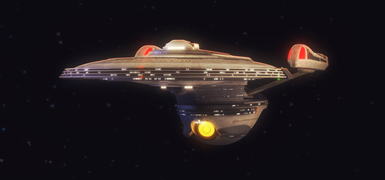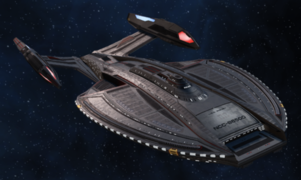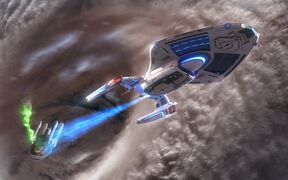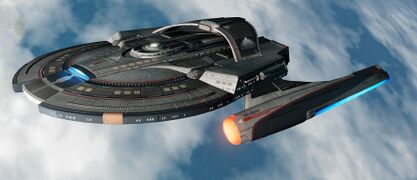|
|
| Line 1: |
Line 1: |
| {{Specification | | {{Squadron |
| | image = [[image:Jupiterstation.jpg]]
| | | name = Endeavour Squadron |
| | displayName = '''''Jupiter'' Class'''
| | | seal = |
| | name = Jupiter | | | taskforce = |
| | affiliation = [[United Federation of Planets]] | | | taskgroup = |
| | operator = [[Starfleet]] | | | headquarters = |
| | status = | | | flagship = [[USS Endeavour|USS ''Endeavour'']] |
| | role = Research Facility | | | co = [[bfms_char:68761|Fleet Captain Lionel Jericho]] |
| | type = | | | xo = [[bfms_char:12418|Captain Matt Rourke]] |
| | precedingClass = | | | quadrant = Beta Quadrant |
| | succeedingClass = | | | mission = |
| | dateEntered = 2335 | | }}'''Endeavour Squadron''' is a formation centered around the starship ''Endeavour'', an ''Obena''-class explorer. It is currently under the command of [[bfms_char:68761|Fleet Captain Lionel Jericho]] of the USS ''Triumph.'' The squadron is currently assigned to the rimward Federation border with the [[Romulan Factions]], tackling the many challenges of this difficult region. The squadron is assigned directly to [[Fourth Fleet]] Operations and not one of the fleet's task forces, though is often favoured by Director of Fourth Fleet Intelligence [[bfms_char:16756|Vice Admiral Alexander Beckett]] for special assignments. |
| | productionEnd = | |
| | retired = | |
| | expectedDuration = 100 years
| |
| | expectedRefit = 10 years
| |
| | timeResupply =
| |
| | crewComplement = 550
| |
| | emergencyCap =
| |
| | civilians =
| |
| | populationCap = 1500
| |
| | flightCrew =
| |
| | passengers =
| |
| | length =
| |
| | width =
| |
| | diameter = 938 meters
| |
| | height = 635 meters
| |
| | decks = 50
| |
| | propulsionSystem = 12 Manuvering Thrusters
| |
| | cruiseSpeed =
| |
| | maxSpeed =
| |
| | emergencySpeed =
| |
| | energyWeapons = 12 Type-IX Phaser Arrays
| |
| | torpLaunchers = * 1 dorsal
| |
| * 1 ventral
| |
| | torpPayload = 100 Photon Torpedoes
| |
| | shields = Multi-Layered Shielding System
| |
| | dockingfacilities =
| |
| | shuttleBays = 2 | |
| | shuttles = 12 | |
| | runabouts = 6
| |
| | fighters =
| |
| | aux =
| |
| | msd =
| |
| }} | |
| The '''''Jupiter''-class station''' is a highly-modular research installation found in many different configurations around the Federation. First constructed in the 2330s, this design is one of the most common space stations in Federation space because of its ease of construction and versatility.
| |
|
| |
|
| == Mission Parameters ==
| | The squadron's primary mission is to restore stability in this chaotic region. While ''Endeavour's'' historic mission of diplomacy stands, the squadron's formation under Fleet Captain Jericho demonstrates how seriously [[Starfleet]] takes the border's security. The group is directed to cooperate with friendly local factions and build in-roads with others, and the [[Federation]] remains intent on helping the dispossessed of the Romulan territories becoming self-sufficient and self-governing. Likewise, the assignment of the USS ''Pathfinder'' allows the squadron to pursue opportunities for exploration and scientific discovery opened up by the changes in governments and potential research agreements with new allies. But the region is not without its threats: the influence of the [[Romulan Free State]] and the Tal Shiar, the ambitions of smaller, volatile Romulan factions, the raiding of local pirate and criminal elements, and the renewed manipulations of the renegade [[House of Mo'Kai]], keen to exploit the chaos for their own interests. |
| Most Jupiter-class stations, like the original over Jupiter in the Sol system, are research facilities. They conduct research that is too dangerous to be undertaken on a planet’s surface or requires microgravity conditions. Unlike the smaller Regula-class, they are more spacious, more modern, but less adaptable, as they are comprised of a small number of large modules rather than a large number of small modules. Examples of missions for this class in the research configuration include research & development, high orbit observation of primitive species, and biological research.
| |
|
| |
|
| Another available configuration is as a hospital station, given that this base can be quickly transported and deployed over a planet encountering a pandemic or other health crisis. These stations can hold several thousand patients without requiring as large a crew as a medical ship, making them ideal for long-term medical situations.
| | ==Composition== |
|
| |
|
| Several Jupiter-class stations are in use as trade outposts where a larger base would be impractical or unnecessary, serving as an orbital depot to handle cargo movement between ground and orbit. In addition, this configuration is used as a customs inspection point on minor trade routes within the Federation.
| | *[[USS Endeavour|USS ''Endeavour'']] - [[Obena Class|''Odyssey''-class explorer]] |
| | **While Fleet Captain Jericho of the ''Triumph'' commands the squadron, ''Endeavour's'' capabilities keep her at the heart of operations, group missions revolving around her. She is a strong diplomatic platform and well-equipped to provide humanitarian aid as much as she is tactically powerful. |
| | *[[USS Triumph|USS ''Triumph'']] - [[Inquiry Class|''Inquiry''-class heavy cruiser]] |
| | **The ''Triumph'' has served for years in significant tactical hot-spots around the quadrant. Fleet Captain Jericho leads the squadron from his ship, which has a primary focus of protecting the diplomatic mission and taking point on any security threats. |
| | *[[USS Pathfinder|USS ''Pathfinder'']] - [[Pathfinder Class|''Pathfinder''-class long-range science vessel]] |
| | **''Pathfinder'' is charged with the squadron's scientific operations, and so usually operates independently. |
| | *[[USS Nighthawk|USS ''Nighthawk'']] - [[Reliant Class|''Reliant''-class frigate]] |
|
| |
|
| A handful of these bases have been built as subspace relay stations and monitoring posts around the Federation where a simple relay station would be insufficient. Their processing capacity allows them to efficiently serve as a hub in the subspace relay network and a base from which Starfleet Intelligence can collect signals intelligence.
| | <gallery mode="packed"> |
| | | File:Endobena1a.png|USS ''Endeavour'' |
| Given that this base is highly modular, though, the possibilities for individual stations are nearly limitless, and each Jupiter is (generally speaking) a unique construction tailored to a particular mission profile.
| | File:Inquiry_class.png|USS ''Triumph'' |
| | | File:Pathfinder_Rescue_01.jpeg|USS ''Pathfinder'' |
| == Engineering ==
| | File:Reliant1.jpg|USS ''Nighthawk'' |
| Jupiter-class stations are made up of saucer-shaped modules joined together with bridges and attached to reactor spires. The main modules contain habitation space, as well as cargo holds, science labs, and whatever facilities the base needs to carry out its primary mission, whether that be scientific, commercial, or (rarely) defensive, while the connecting pieces provide structural support and contain systems like the power and shield generators, communications arrays, and sensors. Most Jupiter-class stations consist of two stacks of three saucers joined by interconnecting bridges at all three levels and reactor spires attached to both stacks, though there are many permutations, ranging from a single saucer with a reactor spire to four stacks of saucers joined together, depending on the specific needs of individual bases. The saucer modules are structurally similar to the saucers used aboard Ambassador-class ships, but it is a common misconception that they are actually discarded starship components.
| | </gallery> |
| | |
| The long spires attached to the saucer stacks contain the station’s primary fusion reactors, which provide main power. Engineering control is maintained from smaller disk-shaped modules between the saucer stack and the reactor spire. Communications equipment is also attached to these spires. The top of the station also contains aerials for communication and sensor equipment.
| |
| | |
| Secondary power is provided through solar panel arrays attached either to the interconnecting bridges for multi-tower set-ups or to the central column of the saucer stacks, limiting the need to resupply distant outposts.
| |
| | |
| == Docking and Cargo Facilities ==
| |
| Jupiter-class stations do not have internal starship berths, and while they do have standard docking ports, most do not have the docking booms required for large ships to dock safely with them. Beyond this, they also don’t hold large supplies of fuel or other consumables to resupply starships, so they make poor waystations for that purpose.
| |
| | |
| Shuttle and runabout facilities are located between the saucers, and these stations carry a small complement of each. For the variants of this type used as commercial facilities, these bays are the primary transfer hubs from orbiting freighters to the station’s cargo holds for items that cannot be transported, with large cargo elevators spanning the height of the station and connecting to holds in the center of each saucer.
| |
| | |
| == Defensive Capabilities ==
| |
| Most Jupiter-class facilities are either located within systems with another Starfleet presence to keep them safe or don’t engage in operations that require weapons, and so most have limited armaments. They have robust shield systems, which allow them to wait for help if they are attacked, but are often only potential targets if they house advanced technology or potentially valuable information. As such, their defensive capabilities are focused on deterring or repelling potential raiders rather than resisting military assault. They can be equipped with phaser arrays on their saucer sections through purpose-built modules or attached tactical pods, but they rely more heavily on their secondary ships or nearby Starfleet support for protection. In general, it is always preferable to build nearly any other type of station when the need for defenses is anticipated.
| |
| | |
| == Civilian Population ==
| |
| Most ''Jupiter''-class stations are either purely Starfleet or a mix of Starfleet and Federation civilian specialists and do not house substantial civilian populations. This isn’t the sort of space station that’s a city in space; it’s a specialized research, trade, or observation post. Any civilians that are onboard are invited onboard to work in roles like managing lounges and restaurants or other crew support roles if they aren’t mission specialists.
| |
| | |
| == Station Life ==
| |
| Life on board a ''Jupiter''-class is often very comfortable. Crew are expected to often commit long-term to research projects aboard, sometimes deep within Federation space where resources are plentiful and citizens expect a higher standard of living. Personal quarters are generous; junior enlisted have their own bedrooms but share living space with one to three others, while more senior crew have their own living space and separate sleeping areas. All but the most resource-intensively configured ''Jupiters'' are built with a saucer module heavily dedicated to recreation facilities, which include holodeck space for personal use, an arboretum, a gymnasium, and room for a small handful of civilian-run eateries.
| |
| | |
| The crew of a ''Jupiter''-class often live far from danger in a facility purpose-built for their area of professional expertise, and the staff are normally deeply committed to a life of generally unvaried work far from wider society. Serving aboard a ''Jupiter''-class offers an intellectually-fulfilling lifestyle alongside like-minded colleagues, but even by Starfleet standards a healthy work-life balance can be difficult.
| |
| | |
| == History ==
| |
| The first constructed was the eponymous ''Jupiter'' Station, replacing an aging facility in the Sol System that predated the founding of the Federation. Though built to develop computer science technology, the designers knew that inhabitants would expect it to offer space and comfort due to its proximity to Earth, and a whole saucer module of Jupiter Station itself is committed to recreation and hospitality. Other stations constructed in the wake of Jupiter Station's success may not share these luxuries, but the need for modernity and comfort has largely persisted across designs.
| |
| | |
| In 2399, ''Jupiter''-class stations are deployed either as research outposts in safe frontiers, or development facilities within secure Federation borders.
| |
| | |
| == ''Jupiter''-class Stations of the Fourth Fleet ==
| |
| The following ''Jupiter''-class stations have been assigned to support operations of Starfleet's [[Fourth Fleet]]:
| |
| | |
| * [[Cormorant Station]], near the border with the [[Romulan Republic]]
| |
| | |
| == ''Jupiter''-class Stations In Play ==
| |
| * Due to their modular design, each ''Jupiter''-class is different depending on its research purpose. There is variety in laboratory space and use, recreation facilities, and sensor arrays and capabilities.
| |
| * Expected to often house a significant population of non-Starfleet researchers, sometimes deep within Federation space, ''Jupiter''-classes are usually modern and comfortable.
| |
|
| |
|
| {{clear}} | | {{clear}} |
| [[Category:Federation Space Station Classes]]
| |



